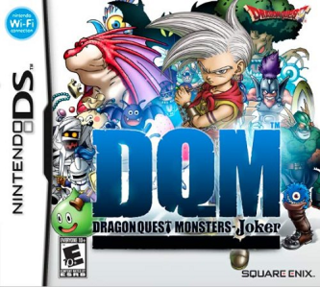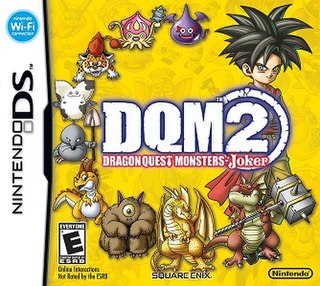Dragon Quest, previously published as Dragon Warrior in North America until 2005, is a series of role-playing games created by Japanese game designers Armor Project, Bird Studio and Sugiyama Kobo to its publisher Enix, with all of the involved parties co-owning the copyright of the series since then. The games are published by Square Enix since its inception, with localized remakes and ports of later installments for the Nintendo DS, Nintendo 3DS, and Nintendo Switch being published by Nintendo outside of Japan. With its first game published in 1986, there are eleven main-series games, along with numerous spin-off games. In addition, there have been numerous manga, anime and novels published under the franchise, with nearly every game in the main series having a related adaptation.
Dragon Quest Monsters is a spin-off series of the Dragon Quest games. Primarily developed by Tose and published by Square Enix, it sets the player in a medieval/fantasy world filled with magic, monsters and knights. Unlike the original Dragon Quest games, the player's character does not do any of the fighting in battles; instead the player has to rely on capturing, breeding and raising monsters to do the fighting for them. The concept originated from Dragon Quest V (1992). The character and monster designs are by Dragon Ball creator, Akira Toriyama. The series spans several handheld gaming systems, and each game has received positive reviews from critics. The series' gameplay has been compared to Pokémon.

Dragon Quest IV: Chapters of the Chosen, titled Dragon Warrior IV when initially localized to North America, is a role-playing video game, the fourth installment of the Dragon Quest video game series developed by Chunsoft and published by Enix, and the first of the Zenithian Trilogy. It was originally released for the Famicom on 11 February 1990 in Japan. A North American NES version followed in October 1992, and would be the last Dragon Quest game localized and published by Enix's Enix America Corporation subsidiary prior to its closure in November 1995, as well as the last Dragon Quest game to be localized into English prior to the localization of Dragon Warrior Monsters in December 1999. The game was remade by Heartbeat for the PlayStation, which eventually was available as an Ultimate Hits game. The remake was ported by ArtePiazza to the Nintendo DS, released in Japan November 2007 and worldwide in September 2008. A mobile version based on the Nintendo DS remake was released in 2014 for Android and iOS.

Dragon Quest VI: Realms of Revelation, known in Europe as Dragon Quest VI: Realms of Reverie, is a role-playing video game developed by Heartbeat and published by Enix for the Super Famicom as a part of the Dragon Quest series and as the last Dragon Quest game in the Zenithian Trilogy. It was released in Japan in December 1995, developed by Heartbeat; whereas the previous Dragon Quest games were developed by Chunsoft. In 2011, a remake of the game, along with Dragon Quest IV and Dragon Quest V, was released worldwide for the Nintendo DS, making this the first time the game was released in English. Another version of the game for Android and iOS devices was released in Japan in June 2015.

Dragon Quest VIII: Journey of the Cursed King is a role-playing video game developed by Level-5 and published by Square Enix for the PlayStation 2. It was released in Japan in 2004, in North America in 2005 and PAL regions in 2006, making it the first main series installment released in the PAL region. It is the eighth installment of the Dragon Quest series and it is the first English version of a Dragon Quest game to drop the Dragon Warrior title. A version of the game for Android and iOS was released in Japan in December 2013, and worldwide in May 2014.

Torneko: The Last Hope is a 1999 role-playing video game for the PlayStation. The game was co-developed by Chunsoft and Matrix Software and published by Enix. In Japan, the game was ported to the Game Boy Advance in 2001.

Dragon Quest Monsters: Caravan Heart is the third game in the Dragon Quest Monsters series, released only in Japan by Enix for the Game Boy Advance. The game was simultaneously announced with Dragon Quest VIII in Famitsu in 2002. Like the other Dragon Quest titles, development of Caravan Heart was led by Yuji Horii.

Tose Co., Ltd. is a Japanese video game development company based in Kyoto. It is mostly known for developing Nintendo's Game & Watch Gallery series, various Dragon Ball games, as well as other Nintendo products. Tose has developed or co-developed over 1,000 games since the company's inception in 1979, but is virtually never credited in the games themselves. Tose maintains a policy of having no creative input into the work they do, going so far as to refuse to put their names in the credits for most of the games they work on. As such, Tose has gained a reputation for being a "ghost developer".

Dragon Quest Monsters: Joker is a 2006 role-playing video game developed by Tose and published by Square Enix for the Nintendo DS. It is the fourth installment of the Dragon Quest Monsters series. This was the first game in the series to have online play, done using Nintendo Wi-Fi. A sequel, Dragon Quest Monsters: Joker 2, was released in 2010.

Dragon Quest Monsters, released in North America as Dragon Warrior Monsters, is the first video game in the Dragon Quest Monsters series. It was released in Japan by Enix on September 25, 1998, and co-published by Eidos Interactive in Europe and North America in 2000. It was the first Dragon Quest game to be released in Europe. The game cartridge is compatible with both the black-and-white Game Boy and the Game Boy Color; a second printing of the game was made after the Game Boy Color itself was released. The game was remade for the PlayStation in a compilation Dragon Quest Monsters 1+2 Hoshi Furi no Yūsha to Bokujō no Nakamatachi. A mobile phone incarnation titled Dragon Quest Monsters i was released in Japan on January 28, 2002.

Dragon Quest X: Rise of the Five Tribes Online, also known as Dragon Quest X Online, is a massively multiplayer online role-playing game (MMORPG) developed and published by Square Enix. It is the tenth mainline entry in the Dragon Quest series. It was originally released for the Wii in 2012, and was later ported to the Wii U, Windows, PlayStation 4, Nintendo Switch, Android, iOS, and Nintendo 3DS, all of which support cross-platform play. Other than a discontinued Windows version in China, the game was not released outside of Japan. A single-player remake, titled Dragon Quest X Offline, was released in 2022 in Japan. It is also set to release in other Asian regions in 2024.

Dragon Quest Monsters: Joker 2 is a 2010 role-playing video game developed by Tose and published by Nintendo for the Nintendo DS. It is the sequel to Dragon Quest Monsters: Joker (2006) and is the fifth game in the Dragon Quest Monsters series. A sequel, Dragon Quest Monsters: Joker 3, was released in 2016.

Dragon Quest Heroes: The World Tree's Woe and the Blight Below is a hack and slash game developed by Omega Force and published by Square Enix. It was released for PlayStation 3 and PlayStation 4 in Japan in February 2015, and in North America, Australia and Europe only for PlayStation 4 in October 2015. It was later released for Microsoft Windows in December 2015. The game received generally positive reviews, with a sequel Dragon Quest Heroes II being released in Japan during May 2016. Dragon Quest Heroes would later be released with the sequel in a compilation for Nintendo Switch in Japan.

The Japanese video game magazine Famitsu reviews video games by having four critics each assign the game a score from 0 to 10, with 10 being the highest score. The scores of are then added together for a maximum possible score of 40. As of 2024, thirty games have received perfect scores from Famitsu.

Dragon Quest Builders is a 2016 sandbox action role-playing game developed and published by Square Enix for the PlayStation 3, PlayStation 4, PlayStation Vita, Android iOS, and Microsoft Windows and published by Nintendo for Nintendo Switch.

Dragon Quest XI: Echoes of an Elusive Age is a role-playing video game by Square Enix. The eleventh entry in the long-running Dragon Quest video game series, it was released in Japan for the Nintendo 3DS and PlayStation 4 in July 2017 and worldwide for the PlayStation 4 and Windows in September 2018. An enhanced version, Dragon Quest XI S: Echoes of an Elusive Age - Definitive Edition, was released for Nintendo Switch by Nintendo in September 2019; for PlayStation 4, Windows, and Xbox One in December 2020; and for Stadia in March 2021.

Dragon Quest Monsters: Joker 3 is a 2016 role-playing video game developed by Tose and published by Square Enix for the Nintendo 3DS. It is the sequel to Dragon Quest Monsters: Joker 2 (2010), and is the sixth game in the Dragon Quest Monsters series.

Psaro is a character in the 1990 video game Dragon Quest IV. He is the primary antagonist of the story, leading a charge to wipe out humanity for the sake of demons, particularly due to his infatuation for an elf named Rose, who suffered under humans. He wishes to find and kill the human prophesized to one day defeat him, which causes him or his minions to come into contact with one or more of the multiple main heroes of the game who later come to support the prophesized hero in their quest.

Alena is a character in the 1990 video game Dragon Quest IV, one of its main characters. She is the star of the second chapter, going out to explore the world and become a strong warrior with her retainers Kiryl and Borya, before discovering her kingdom wiped out. She later joins with the protagonist of the game in their quest to defeat the leader of the monsters, Psaro, and save the world. Her design was created by Akira Toriyama, and she is voiced in Japanese by Shoko Nakagawa. She is a fan favorite Dragon Quest IV character, noted as a strong female character by multiple critics, one from RPGFan noting how rare this was on the NES.

















